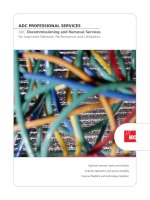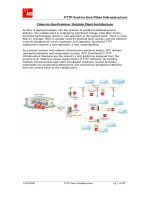Tài liệu ADC’s Hardened Connector Technology docx
Bạn đang xem bản rút gọn của tài liệu. Xem và tải ngay bản đầy đủ của tài liệu tại đây (223.89 KB, 4 trang )
CASE STUDY
Richland-Grant Telephone Cooperative Relies on
ADC’s Hardened Connector Technology to Achieve
Fast, Low-Cost Network Installation
BACKGROUND
Established in 1951, Richland-Grant Telephone Cooperative (RGTC) is
an independent local exchange carrier serving customers throughout
Southwestern Wisconsin. Based in Blue River, Wis., the company offers
area-wide telephone service, along with long-distance access, wide-area
paging, voice mail, and local- and wide-area networks. The company
also is a member of Midwest Tel Net, a consortium of eight regional
telephone companies that provide local Internet access throughout much
of Southwest Wisconsin.
Since its inception, RGTC has remained committed to providing
dependable, high-quality telephone service at the lowest cost
possible. To meet its delivery goals, it’s important that RGTC keep its
communications technology on the cutting edge of emerging trends.
Creating an efficient, scalable infrastructure capable of meeting its
customers’ long-term needs was one of the primary reasons the
company decided to implement a fiber-to-the-home (FTTH) distribution
network for several new housing developments in its service area,
including: Blue River, Boaz, Sabin, Soldiers Grove and Gays Mills.
“We knew that our existing copper infrastructure would not be able to
provide us with the bandwidth and flexibility we needed to meet the
service demands of our growing customer base,” said Dave Lull, general
manager of Richland-Grant Telephone Cooperative. “Implementing a
FTTH infrastructure in these new communities will allow us to efficiently
deliver true broadband services and scale the network as needed to
generate revenues more quickly.”
CHALLENGE
The first community scheduled for fiber
installation was Soldiers Grove. One of the key
decisions that RGTC needed to make early in the
planning stages of this initial project was selecting
the access terminals that would provide a flexible
and secure interface for the fiber network. As a
key component in the distribution framework, it
was critical that these access terminals support
fast and easy installation and enable simple, low-
cost upgrades and expansions as needed.
To meet its needs, RGTC selected ADC’s
OmniReach
™
fiber drop cables and Multiport
Service Terminals (MSTs). The MST access
terminals, which enable use of connectors rather
than splices for service turn-up, provide RGTC
with a reliable interface and a cost-effective,
centralized method of distribution. Use of
connectors rather than splices at access terminals
in neighborhoods allows RGTC to reduce the time
required for installation and service activation,
while helping to simplify technology upgrades in
the future.
“We needed an effective and economical way to
connect and distribute fibers in the field, but we
also needed an interface that was durable and
flexible enough to withstand the harsh, and often
unpredictable, conditions in the outside plant
environment,” Lull said. “After reviewing the ADC
products, we were convinced they would deliver
the performance and cost-efficiency benefits we
needed.”
THE SOLUTION
The distribution architecture on this project
consisted of main feeder cables from the central
office, each of which is terminated at centralized
hubs within the subdivision. The fiber optic ports
at these hubs are linked by fiber distribution
cables to the ADC MST access terminals deployed
closer to smaller clusters of homes. An ADC fiber
drop cable connects homes to access terminals,
creating a fiber path that extends all the way
from the CO to the optical network terminal at
the home. This enables RGTC to deliver each
customer with up to one gigabit of bandwidth.
Key benefits of the OmniReach access terminals
include flexibility and ease of installation. MSTs
incorporate a hardened connector technology
that is designed to withstand extreme
temperatures and conditions. The connectors are
factory-terminated and environmentally sealed to
provide a reliable interface for fiber drops. These
attributes helped RGTC achieve a fast, low-cost
installation with the ability to quickly scale services
as needed.
“The fiber connections can be easily expanded as
new homes are built by simply adding new MSTs
as needed,” Lull said. “If the developer opens
up another block of homes, we can just pop in
another MST and begin burying the fiber drops to
these homes as they’re being built.”
The ADC fiber drops are environmentally robust,
yet extremely flexible, enabling rapid, factory-
quality connections to the MST. Designed for both
aerial and buried drop cable applications, the
unique plug and play design saves labor time and
expense while providing a durable and reliable
service connection.
Arrow on hardened connector shell ensures precise
alignment of connector into optical port.
CASE STUDY
ADC's hardened connector and adapter
CASE STUDY
THE BENEFITS
The flexible mounting options and port
configurations of the ADC MSTs also were key
factors in their selection. Mounting options
include pole, pedestal, hand hole, or stand to
support both aerial and below grade applications.
Available in 2, 4, 6, 8 and 12 port sizes, the
MSTs allowed RGTC to purchase the optimum
number of ports it needed for each deployment
location, and the variety of mounting options
gave installers the flexibility they needed to make
adjustments on-the-fly.
In addition, the hardened connector interface
provided by the MST provides an intuitive test
access point not found with spliced drop options.
The connectorized terminal allows for simple
access through insertion of a test cable into the
hardened interface. In addition to providing easier,
less time-consuming testing, the connector pairs
offer lower skill-set requirements and much less
risk to the fiber for testing.
Service turn-up is another area where the MSTs
offer a distinct benefit over splicing.
“With new developments like Soldiers Grove,
service turn-ups will not occur all at once,” Lull
said. “With the connectorized MST interfaces,
the distribution fibers are simply plugged into
the splitter output and service turn-up becomes
as simple as mating two connectors. This
saves additional cost by using regular installers
for service activation rather than relying on
technicians or splicers.”
Not surprisingly, one of the biggest areas of
savings for RGTC was the reduced labor cost for
service turn-up. With other solutions, installers
would have to splice to hook up homes, which
would have involved the additional costs of
more time and expertise. Instead, use of factory-
terminated connectors hardened for the outside
plant environment reduced the cost of turning-up
service for each home.
“The MSTs and the fiber drops were two of the
most important components in terms of helping
us meet our performance, flexibility and cost-
efficiency goals,” Lull said. “Our goal was to
implement a reliable, cost-effective connector
solution and the ADC products definitely came
through on all accounts.”
“Our goal was to implement
a reliable, cost-effective
connector solution and the
ADC products definitely came
through on all accounts.”
ADC's hardened connector drop cables
Web Site: www.adc.com
From North America, Call Toll Free: 1-800-366-3891 • Outside of North America: +1-952-938-8080
Fax: +1-952-917-3237 • For a listing of ADC’s global sales office locations, please refer to our Web site.
ADC Telecommunications, Inc., P.O. Box 1101, Minneapolis, Minnesota USA 55440-1101
Specifications published here are current as of the date of publication of this document. Because we are continuously
improving our products, ADC reserves the right to change specifications without prior notice. At any time, you may
verify product specifications by contacting our headquarters office in Minneapolis. ADC Telecommunications, Inc.
views its patent portfolio as an important corporate asset and vigorously enforces its patents. Products or features
contained herein may be covered by one or more U.S. or foreign patents. An Equal Opportunity Employer
104366AE 3/07 Original © 2007 ADC Telecommunications, Inc. All Rights Reserved
CASE STUDY









